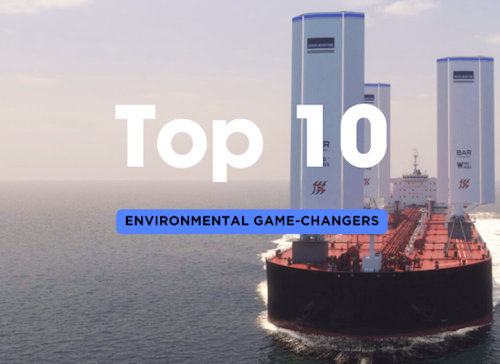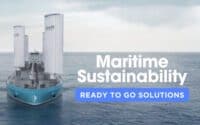Top 10 Pro-Environmental Game Changers in Maritime Shipping

The maritime shipping industry is embracing innovative solutions to reduce its environmental impact and promote sustainability. From wind-assisted propulsion to zero-emission technologies, these game-changing developments are revolutionizing the way ships operate, making them cleaner and more efficient. Today, we explore the top 10 pro-environmental innovations that are helping the industry navigate toward a greener future.

1. Wind-Assisted Propulsion Systems 🌬️
Why It’s a Game Changer:
Harnessing wind for propulsion may seem like a throwback to the age of sail, but modern wind-assisted propulsion systems are revolutionizing the way ships move across oceans. These systems, such as Flettner rotors, wing sails, and even giant kites, leverage the wind to provide additional thrust, significantly reducing the need for fossil fuels. This can lead to substantial fuel savings and lower emissions, contributing to both environmental and financial sustainability.
Key Benefits:
- Fuel Savings: Ships equipped with wind-assisted propulsion can reduce fuel consumption by 10-20%, depending on the wind conditions and the specific technology used.
- Lower Greenhouse Gas Emissions: By reducing the amount of fuel burned, wind-assist systems cut down on carbon dioxide (CO2), sulfur oxides (SOx), and nitrogen oxides (NOx) emissions, helping ships meet increasingly stringent environmental regulations.
- Scalability: These systems can be retrofitted onto existing ships or integrated into new builds, making them a flexible option for a wide range of vessels.
Example:
BAR Technologies has been at the forefront of wind-assisted propulsion with their WindWings technology. These large, solid wings harness the wind to provide supplementary propulsion, leading to fuel savings of up to 30% in optimal conditions. BAR’s innovative designs have been successfully trialed on various commercial vessels, demonstrating the potential for wind-assist systems in the maritime industry.
BAR Technologies (Wind-Assisted Propulsion)
- Website: https://www.bartechnologies.uk
The Future:
As technology advances, wind-assisted propulsion could become a standard feature on long-haul shipping routes, particularly in regions with favorable wind conditions. The combination of wind power with traditional engines or hybrid systems holds immense potential for a greener future in shipping.
2. Solar-Powered Ships ☀️
Why It’s a Game Changer:
Solar power is emerging as a key player in the maritime industry, especially for providing clean energy for onboard systems. While fully solar-powered cargo ships may still be a few years away, solar panels installed on ships can significantly reduce reliance on diesel generators, cutting down fuel consumption and emissions. Solar energy is particularly effective for powering onboard lighting, heating, cooling systems, and communication tools, leading to a greener operation.
Key Benefits:
- Reduced Fuel Consumption: Solar panels reduce the need for auxiliary engines, which typically run on diesel fuel, thereby cutting overall fuel use.
- Zero Emissions: Solar power is a clean, renewable energy source that produces no emissions during operation, making it an ideal solution for reducing a ship’s carbon footprint.
- Cost Savings: Once installed, solar panels have minimal maintenance costs and provide free energy from the sun, helping to offset initial installation expenses over time.
Example:
The “Energy Observer” is a fully self-sufficient vessel powered by a combination of solar panels, wind turbines, and hydrogen fuel cells. This showcases the potential for renewable energy to drive maritime vessels with minimal environmental impact.
The Future:
As solar technology improves, ships could rely more heavily on solar power, with larger solar arrays providing a more significant portion of a ship’s energy needs. In combination with other renewable technologies, solar-powered ships could revolutionize green shipping practices.
3. LNG (Liquefied Natural Gas) as a Cleaner Fuel 🛢️
Why It’s a Game Changer:
Liquefied Natural Gas (LNG) is rapidly becoming a popular alternative to traditional heavy fuel oils used in shipping. LNG is a cleaner-burning fuel, emitting far fewer pollutants, including sulfur oxides (SOx), nitrogen oxides (NOx), and particulate matter. Although LNG is still a fossil fuel, its use represents a significant step toward reducing the environmental impact of maritime shipping.
Key Benefits:
- Lower Emissions: LNG produces 20-30% less CO2 than conventional marine fuels and virtually eliminates SOx and particulate matter emissions, making it a preferred option for shipping companies operating in Emission Control Areas (ECAs).
- Compliance with Regulations: The IMO’s 2020 sulfur cap has accelerated the adoption of LNG, as it helps ships meet strict sulfur emission limits without needing scrubbers or other costly retrofits.
- Scalability: LNG infrastructure is growing globally, making it easier for ships to refuel in major ports. As the supply chain for LNG expands, more ships can make the transition.
Example:
CMA CGM, one of the world’s largest container shipping companies, launched a fleet of LNG-powered vessels, including the giant “CMA CGM Jacques Saade,” which is the largest LNG-powered container ship in the world.
CMA CGM Jacques Saade (LNG-Powered Ships)
- Website: https://www.cmacgm-group.com
The Future:
While LNG is not a perfect solution due to its methane emissions, it is seen as a transitional fuel that will help the industry move toward zero-emission fuels in the future. Further development in methane slip reduction technology and the potential blending of LNG with hydrogen could make it an even cleaner option in the years to come.
4. Hydrogen-Powered Ships 💧
Why It’s a Game Changer:
Hydrogen is emerging as a clean fuel alternative with enormous potential for maritime shipping. Hydrogen fuel cells generate electricity by combining hydrogen and oxygen, producing only water vapor as a byproduct. This makes hydrogen one of the cleanest energy sources available, offering a zero-emission solution for the shipping industry. As the technology matures and infrastructure develops, hydrogen-powered ships could be a game changer in the quest for carbon neutrality.
Key Benefits:
- Zero Emissions: Hydrogen-powered ships produce no carbon dioxide (CO2), sulfur oxides (SOx), or nitrogen oxides (NOx), making them an excellent option for achieving zero emissions.
- Versatility: Hydrogen can be used in both fuel cells and combustion engines, providing flexibility in its application across different types of vessels.
- Renewable Production: Hydrogen can be produced through electrolysis using renewable energy sources, further reducing its environmental footprint.
Example:
The “Hydroville” by CMB is one of the first hydrogen-powered passenger ferries, operating in Belgium. The vessel uses both hydrogen and diesel, demonstrating the feasibility of hybrid systems as a stepping stone toward fully hydrogen-powered ships.
CMB Hydroville (Hydrogen-Powered Ships)
- Website: https://www.cmb.tech
The Future:
The development of hydrogen storage and refueling infrastructure is critical for wider adoption. As more ports invest in hydrogen facilities and technology advances, hydrogen-powered ships could become the norm for short-sea shipping and potentially even long-haul vessels.
5. Biofuels for Sustainable Shipping 🌿
Why It’s a Game Changer:
Biofuels, derived from organic materials such as algae, agricultural waste, or used cooking oil, offer a sustainable alternative to fossil fuels. They are considered carbon-neutral because the carbon dioxide (CO2) released during combustion is offset by the CO2 absorbed during the growth of the biomass used to produce the fuel. As biofuel production scales up, it can serve as a drop-in replacement for conventional marine fuels, offering a way to reduce emissions without requiring major changes to ship engines or infrastructure.
Key Benefits:
- Reduced Carbon Footprint: Biofuels can reduce greenhouse gas emissions by up to 80% compared to traditional marine fuels, helping ships meet stringent emission targets.
- Compatibility with Existing Engines: Many biofuels are compatible with existing marine engines, requiring no major retrofitting or new infrastructure, making them a cost-effective and scalable solution.
- Renewable Resource: Biofuels are made from renewable sources, reducing the industry’s reliance on fossil fuels and contributing to the circular economy.
Example:
GoodFuels, a pioneer in sustainable biofuels, has successfully partnered with shipping companies like Stena Bulk and Boskalis to fuel their vessels with biofuels. This has shown a reduction in carbon emissions without compromising on performance.
GoodFuels (Biofuels for Sustainable Shipping)
- Website: https://goodfuels.com
The Future:
As more shipping companies adopt biofuels, the demand for sustainable fuel sources will continue to grow. Advances in production technologies and government incentives could further lower costs and accelerate adoption, making biofuels a central player in the maritime fuel market.
6. Air Lubrication Systems 💨
Why It’s a Game Changer:
Air lubrication systems work by creating a layer of micro-bubbles along the bottom of a ship’s hull, reducing friction between the hull and the water. This innovative technology reduces drag, allowing ships to move more efficiently through the water, resulting in significant fuel savings and reduced greenhouse gas emissions. Air lubrication is a retrofit-friendly technology that can be installed on both new and existing ships, offering a quick and effective way to boost fuel efficiency.
Key Benefits:
- Fuel Savings: Air lubrication can reduce fuel consumption by 5-10%, leading to lower operating costs and reduced CO2 emissions.
- Reduced Hull Fouling: The system can also reduce biofouling by making it more difficult for marine organisms to attach to the hull, further improving efficiency.
- Easy Retrofit: Air lubrication systems can be added to existing vessels, making them a practical and accessible option for fleet operators looking to reduce their environmental impact without replacing ships.
Example:
Silverstream Technologies has developed a leading air lubrication system that has been installed on multiple vessels, including Carnival Corporation’s cruise ships. Trials have shown fuel savings of up to 8%, demonstrating the system’s effectiveness.
Silverstream Technologies (Air Lubrication Systems)
- Website: https://www.silverstream-tech.com
The Future:
As fuel prices rise and emission regulations tighten, air lubrication systems will likely become a standard feature in both new ship designs and retrofitted vessels. With the potential to significantly reduce operational costs and emissions, this technology could become a key part of the industry’s transition to greener shipping.
7. Cold Ironing (Shore Power) ⚡
Why It’s a Game Changer:
Cold ironing, also known as shore power, allows ships to turn off their diesel engines while docked at port and plug into the local electrical grid instead. This drastically reduces air pollution and greenhouse gas emissions in ports, where ships would otherwise keep their engines running to power onboard systems. Cold ironing is particularly valuable in reducing emissions in urban areas where ports are located close to large populations.
Key Benefits:
- Immediate Emissions Reduction: By using grid electricity, ships can cut emissions such as sulfur oxides (SOx), nitrogen oxides (NOx), and carbon dioxide (CO2) by up to 98% while docked.
- Cleaner Air in Ports: Shore power helps improve air quality in port cities, reducing health risks for nearby residents and port workers.
- Integration with Renewable Energy: As more ports adopt renewable energy sources like wind or solar, ships using cold ironing can effectively operate with zero emissions while docked.
Example:
The Port of Los Angeles, one of the world’s busiest ports, has implemented cold ironing for many vessels, significantly reducing air pollution in the area. Other major ports, including those in Europe and Asia, are following suit with similar initiatives.
Port of Los Angeles (Cold Ironing)
- Website: https://www.portoflosangeles.org
The Future:
As more ports install the necessary infrastructure, cold ironing will become a common practice worldwide, especially in major urban areas. The use of renewable energy sources to power shore electricity grids will further enhance the environmental benefits of this technology.
8. Waste Heat Recovery Systems ♻️
Why It’s a Game Changer:
Ships produce a large amount of waste heat during engine operation, which is typically lost to the environment. Waste heat recovery systems capture this heat and convert it into usable energy, reducing the need for additional fuel and lowering emissions. These systems improve overall energy efficiency and reduce fuel consumption, making them a crucial technology for sustainable maritime operations.
Key Benefits:
- Fuel Savings: Waste heat recovery systems can improve fuel efficiency by up to 10%, translating to lower fuel consumption and reduced greenhouse gas emissions.
- Reduced Emissions: By repurposing waste heat, ships burn less fuel, which results in fewer emissions of carbon dioxide (CO2), sulfur oxides (SOx), and nitrogen oxides (NOx).
- Increased Energy Efficiency: Ships equipped with these systems can generate additional electricity to power onboard systems, reducing reliance on auxiliary engines.
Example:
Wärtsilä, a leader in marine technology, has developed highly efficient waste heat recovery systems that have been installed on numerous ships. These systems have shown significant reductions in both fuel consumption and emissions.
Wärtsilä (Waste Heat Recovery Systems)
- Website: https://www.wartsila.com
The Future:
Waste heat recovery systems will become increasingly standard on new builds and retrofits as the maritime industry seeks to improve energy efficiency and reduce environmental impact. Continued innovation will likely improve the effectiveness of these systems, making them even more attractive for shipowners looking to cut costs and emissions.
9. Ballast-Free Ship Designs 🌍
Why It’s a Game Changer:
Ballast water, used to stabilize ships, is often transferred from one region to another, introducing invasive species that disrupt marine ecosystems. Ballast-free ship designs eliminate the need for ballast water altogether, thus preventing the spread of invasive species and reducing the environmental impact associated with ballast water management.
Key Benefits:
- No Invasive Species Transfer: By eliminating ballast water, ships no longer pose a risk of introducing harmful species into new ecosystems.
- Simplified Operations: Without the need for ballast water, ships reduce their reliance on complex treatment systems, which saves time and maintenance costs.
- Environmental Protection: Ballast-free ships help protect marine biodiversity and preserve the ecological balance in sensitive environments.
The Future:
As the shipping industry seeks to minimize environmental impact, ballast-free ship designs could become more widespread. Although the technology is still in its early stages, it has the potential to revolutionize shipbuilding by simplifying ballast management and protecting marine environments.
10. Hybrid and Electric Propulsion Systems 🔋
Why It’s a Game Changer:
Hybrid and fully electric propulsion systems are rapidly gaining traction in the maritime industry as a way to significantly reduce emissions and fuel consumption. Hybrid systems combine traditional engines with electric propulsion, while fully electric ships run entirely on battery power, making them ideal for short-sea shipping and ferries. These systems offer a cleaner and quieter alternative to conventional marine engines.
Key Benefits:
- Zero Emissions for Electric Ships: Fully electric ships produce no emissions, making them ideal for environmentally sensitive areas and emission-controlled zones.
- Fuel and Emissions Savings with Hybrids: Hybrid systems can reduce fuel consumption by up to 30%, cutting down on CO2, SOx, and NOx emissions.
- Reduced Noise Pollution: Electric and hybrid propulsion systems are significantly quieter than traditional engines, reducing underwater noise pollution that can harm marine life.
Example:
Norwegian company Yara Birkeland is set to launch the world’s first fully electric autonomous container ship. This ship will operate with zero emissions, demonstrating the potential for electric ships in reducing the environmental impact of maritime shipping.
- Yara Birkeland (Hybrid and Electric Propulsion Systems)
- Website: https://www.yara.com
The Future:
As battery technology improves, fully electric ships will become more viable for a wider range of vessels. Hybrid systems will also continue to gain popularity, particularly in the ferry and cruise industries, where reducing fuel consumption and emissions is a top priority.
Table Summary
| ShipUniverse: Top 10 Pro-Environmental Game Changers in Maritime Shipping | |
|---|---|
| Game Changer | Description |
| Wind-Assisted Propulsion Systems | Modern wind-assisted propulsion, such as Flettner rotors and wing sails, leverage wind power to reduce fuel consumption and emissions. Ships using these systems can achieve fuel savings of 10-20%, making them a flexible and scalable solution for reducing reliance on fossil fuels. |
| Solar-Powered Ships | Solar panels on ships reduce the need for diesel engines to power onboard systems. Solar energy provides a clean, renewable source of power, cutting fuel consumption and emissions while lowering operational costs over time. |
| LNG (Liquefied Natural Gas) as a Cleaner Fuel | LNG is a cleaner-burning fuel that significantly reduces emissions of sulfur oxides (SOx), nitrogen oxides (NOx), and carbon dioxide (CO2). It helps ships meet stricter environmental regulations, though further innovation is needed to address methane emissions. |
| Hydrogen-Powered Ships | Hydrogen fuel cells generate electricity with zero emissions, producing only water vapor as a byproduct. Hydrogen is a promising clean energy source for ships, especially as the infrastructure for hydrogen refueling expands globally. |
| Biofuels for Sustainable Shipping | Biofuels, derived from renewable sources like algae and waste, offer a carbon-neutral alternative to traditional fuels. They can reduce greenhouse gas emissions by up to 80% and can be used in existing engines, making them a scalable option for greener shipping. |
| Air Lubrication Systems | Air lubrication systems create a layer of bubbles under the hull to reduce friction between the ship and water. This improves fuel efficiency by 5-10%, lowering emissions and reducing operating costs. It’s an easy retrofit for many existing vessels. |
| Cold Ironing (Shore Power) | Cold ironing allows ships to plug into electrical grids while docked, turning off their engines and cutting emissions by up to 98%. This technology is particularly valuable for improving air quality in port cities and reducing overall emissions. |
| Waste Heat Recovery Systems | Ships produce waste heat during engine operation, but waste heat recovery systems capture this heat and convert it into usable energy. This improves fuel efficiency by up to 10%, reducing emissions and operational costs. |
| Ballast-Free Ship Designs | Ballast-free ship designs eliminate the need for ballast water, reducing the risk of invasive species transfer and simplifying ship operations. These designs protect marine ecosystems while reducing the need for ballast treatment systems. |
| Hybrid and Electric Propulsion Systems | Hybrid systems combine traditional engines with electric propulsion, while fully electric ships run entirely on batteries. Both options significantly reduce emissions and fuel consumption, making them ideal for short-sea shipping and ferries. |

Do you have any feedback or additional insights? Please reach out to editor @ shipuniverse.com



